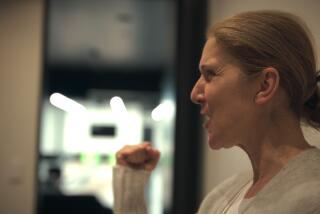Spirit Thrives After 41 Years in Iron Lung : Polio: Dianne Odell says her life is full of love, faith and family; that you can make your life good or bad.
- Share via
JACKSON, Tenn. — After 41 years, Dianne Odell’s memories of a normal life have faded away.
“I remember walking to a ballgame with daddy,” she said, “and I remember being on a train. It seems like I can remember playing out in the mud one day.”
It all happened so long ago--before her body became a useless vessel. She was 3 years old when what was thought to be a cold turned out to be polio, and for the last 41 years, her life has been ruled by an iron lung.
But do not pity Dianne Odell.
“I’ve had a very good life, filled with love and family and faith. You can make life good or you can make it bad,” she said.
“I often wonder what kind of person I would be had I not been handicapped,” she said. “I have a lot of friends who call with their problems and say I cheer them up a little bit. I like being that kind of person, but I might not have been.”
The 7-foot-long respirator encases her twisted body up to the neck, creating a vacuum that forces air into her lungs.
Pinned in the 750-pound metal tube, she can move only her head and facial muscles. But the warmth of a loving family has softened the iron’s grip.
“We’re all very close,” said her mother, Geneva, who is as tied to the lung as her daughter. “I’ve always told Dianne you make your own happiness.”
An avid reader, Odell tutors one to two schoolchildren in her home each year. “I like the little ones the best,” she said. “They’re fascinated by the iron lung. They think everything I say is magic.”
Lying on her back, she talks with visitors by looking in a mirror and operates a telephone, tape deck and TV by blowing into a small tube.
With a tape recorder and volunteer scribes, she is writing a children’s book about a blind boy who makes wishes on a distant star.
“Who else could see a star that can’t be seen but a child who can’t see. He sees it with his heart. I’m trying to get across that, yes, people are going to call you names and not play with you because you’re different. But you can still accomplish something,” she said.
The respirator is turned off only a few minutes at a time for basic nursing care. But in the early years, Odell could breathe on her own for two to three hours a day.
She would attend church then and go outside occasionally in a wheelchair. She could move her left foot. “Mother would put me on a pallet outside and I would play with the other kids in the neighborhood. I would build little castles with my foot in the dirt.”
Odell’s parents insisted on making their daughter’s life as normal as possible. The house was open to neighborhood youngsters, and sisters Donna and Mary were encouraged to host teen-age sleep-overs.
“Most of the kids grew up thinking everyone had a friend in a iron lung,” Odell said. “I have the same friends today that I had when I was 10 years old. When they married, their husbands became my friends. I tutored their children. There was no big difference, really.”
In-home teachers and an intercom system to a nearby school allowed her to earn a high school diploma.
She lived with family friends for a while in hopes of earning a degree in social work at Freed-Hardeman College in nearby Henderson, Tenn. But failing health and the confines of the respirator ended those plans. The college awarded her an honorary degree in 1987; it hangs beside the respirator.
Iron lungs were once common for polio victims, and 500 to 800 are still in use around the country. Many iron lung users do not require them 24 hours a day, however, and small portable equipment is more common.
Odell said her family is looking into the possibility of getting a smaller respirator if her health and limited finances allow it.
Life in an iron lung rarely lasts four decades, said Dr. Robert Christopher, a polio specialist at the University of Tennessee. Unable to cough, such patients choke easily or develop pneumonia.
“I have to assume this woman has had wonderful care from her family. Unless someone was watching her very carefully, she could not have lived as long as she has,” Christopher said.
Dr. Walton Harrison, a pediatrician who has treated Odell most of her life, said she is often in pain from inflamed joints and a twisted spine.
“She has been an inspiration to me ever since I’ve been seeing her. I’ve never heard her complain about her life,” Harrison said. “When I first saw her as a child, I felt she would not live to be an adult.”
But, “As long as she has the support of her family and the determination that she has, she may outlive us all,” he said.
There is much more to her life than survival. Churchgoers have occasionally celebrated the Sabbath at her house. Holidays parties have been frequent, and Halloween trick-or-treaters are invited in to show off their costumes.
Odell has dressed up too.
“I was a package of Lifesavers one year. I was a yellow submarine one year, and once I was a spaceship,” she said.
Sundays are for visits from uncles, aunts and cousins. Her sisters have four sons--”my boys,” she calls them. “The little ones use the respirator like a jungle gym. They come up and give me head hugs and kisses,” she said.
She has drawn on her indomitable attitude to counsel handicapped children; her greatest loss is not having a husband and children of her own.
“Children don’t ask anything but that you love them. Even if you can’t reach out and touch them, they know you care.”


